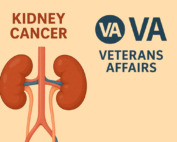Introduction
Veterans who have been diagnosed with cancer may be eligible for disability benefits through the Department of Veterans Affairs (VA). These benefits provide financial support and access to healthcare services, acknowledging the impact that cancer and its treatment can have on a veteran’s life. However, when cancer goes into remission, the process for determining and maintaining VA disability ratings can become more complex.
This article explores how the VA handles disability ratings for cancers in remission, discusses the common causes of service-connected cancers, and offers guidance for veterans navigating the VA disability system.
VA Disability Ratings for Cancers
How VA Disability Ratings are Determined
When a veteran is diagnosed with cancer, the VA typically assigns a 100% disability rating during active treatment, reflecting the severity of the condition and the impact on the veteran’s ability to work.
This rating remains in place during the active phase of the disease, including surgery, chemotherapy, radiation, or other treatments.
The 100% rating acknowledges the significant impairment and potential incapacitation that can result from both the cancer itself and its treatment.
What Happens When Cancer Goes Into Remission?
When cancer goes into remission, the VA begins the process of reevaluating the veteran’s disability rating. The VA does not immediately reduce the rating upon remission; instead, they schedule a reexamination to assess the veteran’s current health status and any residual effects of the cancer or its treatment.
The Reexamination Process
The reexamination process involves a comprehensive review of the veteran’s medical records, along with a new VA medical examination. During this exam, the VA physician will assess any ongoing symptoms or impairments that may be related to the cancer or its treatment, such as:
- Chronic pain: Residual pain from surgery or other treatments.
- Nerve damage: Neuropathy or other neurological issues resulting from chemotherapy or surgery.
- Organ damage: Impairment of organs affected by the cancer or its treatment, such as lung damage from lung cancer.
- Fatigue and weakness: Lingering fatigue that impacts daily functioning.
- Mental health issues: Depression, anxiety, or PTSD related to the cancer experience.
Based on this reexamination, the VA may adjust the veteran’s disability rating. If the cancer is in complete remission with no residual effects, the rating may be significantly reduced, often to 0%. However, if there are ongoing symptoms or disabilities related to the cancer, the VA will assign a new rating that reflects the current level of impairment.
Residual Ratings for Cancer
Even if the cancer is in remission, veterans may be eligible for a residual disability rating if they experience long-term effects from the disease or its treatment. These residual ratings are crucial because they acknowledge the lasting impact of cancer on a veteran’s quality of life, even after the disease itself is no longer active.
For example, a veteran who has undergone surgery to remove a tumor may be left with a significant scar, limited mobility, or chronic pain. Similarly, a veteran who received radiation therapy may suffer from long-term damage to surrounding tissues or organs. The VA will evaluate these residuals and assign an appropriate disability rating based on the severity of the symptoms.
Examples of Residual Ratings
- Scarring and Disfigurement: Veterans who have significant scarring or disfigurement from cancer surgery may receive a rating under the diagnostic codes for scars or disfigurement.
- Organ Dysfunction: If the cancer or its treatment caused damage to a specific organ, such as the lungs, liver, or kidneys, the veteran may receive a rating under the relevant diagnostic code for organ dysfunction.
- Chronic Pain: Veterans experiencing chronic pain related to cancer treatment may be eligible for a rating under the diagnostic codes for chronic pain or nerve damage.
- Mental Health Conditions: Veterans who develop mental health conditions, such as depression or anxiety, as a result of their cancer diagnosis and treatment may receive a rating for those conditions.
Total and Permanent Disability
In some cases, if a veteran’s cancer is deemed to be in remission but there is a high likelihood of recurrence, or if the residual effects are particularly severe, the VA may grant a Total and Permanent (T&P) disability rating. This designation means that the veteran’s condition is not expected to improve, and they will continue to receive benefits at the current rate without the need for further reexaminations.
Common Causes of Service-Connected Cancers
Service-connected cancers are those that can be directly linked to a veteran’s military service. Understanding the common causes of these cancers is essential for veterans seeking VA disability benefits, as establishing a service connection is a critical component of the claims process. Below are some of the most prevalent causes of service-connected cancers.
Burn Pits and Other Environmental Hazards
In more recent conflicts, such as those in Iraq and Afghanistan, veterans have been exposed to a variety of environmental hazards, including burn pits. Burn pits were used to dispose of waste, including toxic materials, and the resulting smoke exposed service members to harmful chemicals.
Cancers potentially linked to burn pit exposure include:
- Lung cancer
- Head and neck cancers
- Leukemia
While the VA has been slower to establish presumptive service connections for burn pit exposure compared to Agent Orange, ongoing research and legislative efforts are helping to expand benefits for affected veterans.
Exposure to Agent Orange
Agent Orange, a herbicide used during the Vietnam War to remove dense vegetation, is one of the most well-known causes of service-connected cancers. The VA presumes that veterans who served in Vietnam or in certain other locations during specific time periods were exposed to Agent Orange, which has been linked to several types of cancer, including:
- Non-Hodgkin’s Lymphoma
- Soft tissue sarcomas
- Prostate cancer
- Bladder cancer
- Lung cancer
Because these cancers are presumed to be related to Agent Orange exposure, veterans do not need to provide evidence of a direct connection between their cancer and their military service to qualify for benefits.
Radiation Exposure
Veterans who were exposed to ionizing radiation during their military service may also develop service-connected cancers. This type of exposure could occur in various ways, including:
- Participation in nuclear weapons testing: Veterans involved in atomic testing or those stationed near testing sites may have been exposed to harmful levels of radiation.
- Occupational exposure: Veterans who worked in roles involving radioactive materials, such as nuclear submarine crews or technicians handling radioactive equipment, are at increased risk.
- Service in Hiroshima or Nagasaki: Veterans who were part of the occupation forces in Japan after the atomic bombings may have been exposed to residual radiation.
Cancers linked to radiation exposure include leukemia, thyroid cancer, and certain types of solid tumors.
Asbestos Exposure
Asbestos, once widely used in military construction and equipment, is another common cause of service-connected cancers. Veterans who worked in shipyards, as mechanics, or in construction roles may have been exposed to asbestos fibers, which can cause serious respiratory illnesses and cancers, including:
- Mesothelioma: A rare but aggressive cancer that affects the lining of the lungs, abdomen, or heart.
- Lung cancer: Particularly among veterans who smoked, asbestos exposure can significantly increase the risk of lung cancer.
- Asbestosis: A chronic lung disease that can lead to lung cancer over time.
Chemical Exposures
Veterans who worked with or around hazardous chemicals during their service may also develop service-connected cancers. For example:
- Benzene exposure: Linked to leukemia and other blood cancers, benzene is a common industrial chemical that veterans might have encountered in fuels, solvents, or other materials.
- Herbicides and pesticides: In addition to Agent Orange, exposure to other herbicides and pesticides can increase the risk of certain cancers, particularly in veterans who served in agricultural roles or in regions where these chemicals were heavily used.
PFAS Exposures
Military personnel and their dependents stationed at certain bases, may have been exposed to extremely high levels of PFAS through drinking contaminated water supplies.
Exposure to PFAS has been associated with several health conditions, including kidney and testicular cancers, thyroid disorders, and liver damage.
While the Department of Veterans Affairs (VA) currently evaluates PFAS-related disability claims on a case-by-case basis, efforts are underway to establish presumptive service connections for certain conditions linked to PFAS exposure.
Veterans who believe their health issues are related to PFAS exposure during military service should consult with healthcare providers and consider filing a disability claim with the VA. It’s essential to provide evidence of exposure and a medical nexus connecting the condition to service-related activities.
Veterans Who Qualify for the AFFF Lawsuit
The use of Aqueous Film-Forming Foam (AFFF) in military settings has led to significant legal actions due to its contamination with per- and polyfluoroalkyl substances (PFAS). These chemicals are known to persist in the environment and the human body, leading to severe health risks, including various forms of cancer. The ongoing AFFF lawsuit is particularly relevant for veterans who were exposed to AFFF-contaminated drinking water during their service.
Eligibility for the AFFF Lawsuit
Veterans who may qualify for the AFFF lawsuit generally include:
-
Military Firefighters: Veterans who served as firefighters in the military and used AFFF regularly during training exercises or in actual fire suppression efforts are at high risk of PFAS exposure. These veterans are among the primary groups eligible to participate in the lawsuit.
-
Service Members at Contaminated Bases: Veterans stationed at military bases where AFFF was used extensively may also qualify. This includes not only firefighters but also other military personnel and military dependents who lived or worked on these bases and were exposed to contaminated water or soil.
-
Veterans with Specific Cancers: Veterans diagnosed with cancers linked to PFAS exposure, such as kidney cancer, testicular cancer, or liver cancer, are strong candidates for the lawsuit. The connection between their cancer and AFFF exposure could be a crucial factor in determining eligibility.
If eligible, your legal team will help you file a claim as part of the AFFF lawsuit. This claim could potentially lead to compensation for medical expenses, lost wages, pain and suffering, and other damages related to your cancer.
You can check your eligibility online here.
Filing a VA Disability Claim for Cancer in Remission
Veterans who are in remission from cancer but still suffer from residual effects should consider filing a VA disability claim or seeking a reexamination if they are already receiving benefits. The process can be complex, but understanding the key steps can help ensure that veterans receive the benefits they are entitled to.
Gathering Evidence
The first step in filing a claim is gathering evidence to support the case. This includes:
- Medical records: Documentation of the cancer diagnosis, treatment, and current status is crucial.
- Service records: These records help establish the connection between the cancer and military service, especially if the cancer is not automatically presumed to be service-connected.
- Doctor’s statements: A statement from a treating physician outlining the residual effects of the cancer and how they impact daily life can strengthen a claim.
Filing the Claim
Veterans can file a claim online through the VA’s eBenefits portal, by mail, or with the assistance of a Veterans Service Officer (VSO). It’s important to include all relevant evidence and ensure that the claim is as comprehensive as possible to avoid delays.
Reexamination and Rating Adjustment
If the veteran is already receiving a 100% disability rating and their cancer is in remission, the VA will schedule a reexamination.
After the reexamination, the VA will either confirm the current rating, reduce it, or assign a new rating based on any residual effects. Veterans have the right to appeal the VA’s decision if they believe it does not accurately reflect their condition.
VA Rating Factors After Successful Cancer Treatment
Residual Effects of Treatment
Treatments such as surgery or radiation often leave residual effects. Pain, scarring, and limitations in mobility can significantly impact the disability rating. These long-term side effects are meticulously evaluated.
Risk of Recurrence
The likelihood and potential severity of the cancer’s return are critical factors. Higher risk levels can result in a higher disability rating. This ensures that veterans receive appropriate support should the cancer reoccur.
Secondary Disabilities Related to Cancer
Cancer and its treatments can lead to secondary disabilities. These conditions may merit their own disability ratings, potentially increasing overall benefits. Key secondary disabilities include:
- Scars: Persistent scars from surgical procedures.
- Lung Damage: Damage from treatments affecting respiratory function.
- Incontinence: Loss of control due to pelvic or abdominal treatments.
Monitoring and Documentation Requirements
Accurate and continuous monitoring of health conditions is crucial. Proper documentation of symptoms, treatments, and secondary conditions supports the evaluation process.
Clinicians’ reports play a significant role, providing detailed insights into the current impact of cancer and its treatments. Veterans should ensure all medical records are thorough and up to date for a precise disability rating evaluation.
By understanding these long-term impacts and documenting them effectively, veterans can optimize their disability benefits even when cancer is in remission.
Cancer and VA Disability FAQs
Key Takeaways
» 100% Initial Rating: Veterans diagnosed with active cancer receive a 100% disability rating from the VA, maintained for six months post-treatment or during ongoing treatment.
» Residual Effects in Remission: When cancer is in remission, the VA evaluates residual side effects and the potential for recurrence to determine disability ratings.
» Service Connection Proof: Establishing a service connection requires demonstrating a current cancer diagnosis, an in-service event or exposure, and a medical nexus linking the diagnosis to military service.
» Factors Affecting Ratings: Exposure to environmental hazards, occupational risks, and specific toxins during service can simplify the process of obtaining a service connection and impact disability ratings.
» Long-Term Monitoring: Continuous health monitoring and thorough documentation of symptoms, treatments, and secondary conditions are crucial for accurate VA disability rating assessments and potential ongoing benefits.
Conclusion
Navigating the VA disability rating system for cancer in remission can be challenging, but it’s vital to understand the nuances to secure the benefits you deserve. By focusing on the long-term impacts of cancer and its treatments, you can ensure your condition is evaluated accurately.
Accurate documentation of your health status, treatments, and any secondary effects is crucial. This thorough record-keeping supports your case and helps adjust your disability rating appropriately.
By securing the appropriate disability rating, veterans can ensure they receive the support they need to manage the long-term effects of cancer and its treatment.




